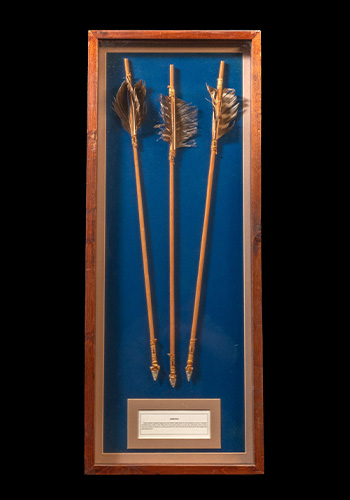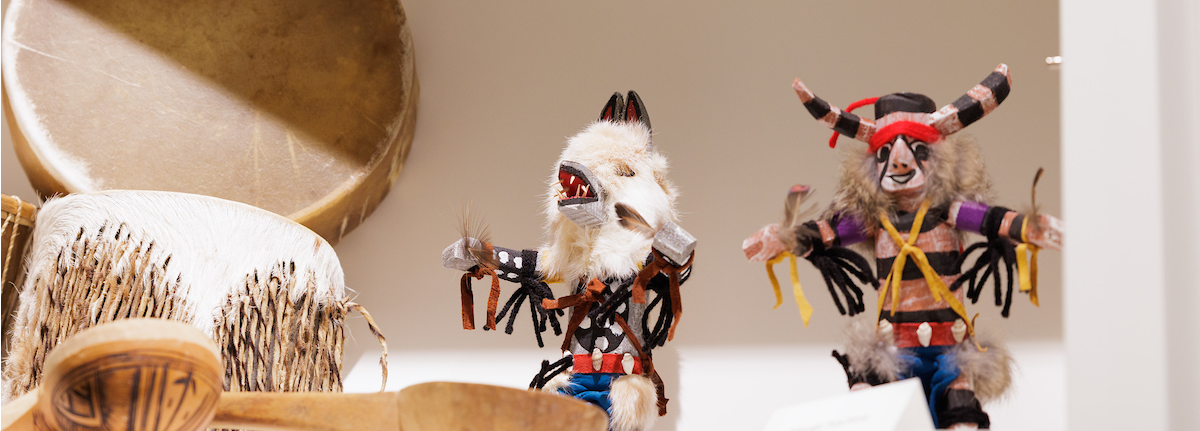Native North Americans
Exploring Native Cultures
Today, Native Americans make up about 1.7 percent of the United States population, or about 5.2 million people. Before European Colonization, North America was home to many aboriginal nations that spoke a variety of languages. The Indigenous Language Institute https://ilinative.org/ estimates that there were once more than 300 indigenous languages spoken in the United States, but only about 175 remain today. As of 2024, The United States has 574 federally recognized Native American tribes and Alaska Native entities. These tribes are also known as nations, bands, pueblos, communities, and native villages.
For more information on Native American Languages, visit: http://www.native-languages.org/
The Native Americans of Texas
Beyond Houston, the state of Texas has three federally recognized tribes: Alabama-Coushatta in Polk County, Kickapoo Traditional in Maverick County, and Ysleta Del Sur Pueblo in El Paso County. They are federally recognized because Texas does not have any governmental mechanism to recognize states.
Traditional Native American Headdress
One of the most recognizable symbols of Native American culture is the traditional Native American headdress, also known as a feathered war bonnet. Worn mostly by Northern and Southern Plains tribes, members wear headdresses to bring them both wisdom and power. In some tribes, men wear the headdress to symbolize a place of profound respect within their tribe. Traditionally, the headdress is composed of a headband made from leather and draped with tribal-specific beading patterns, buffalo fur, and horns. The distinctive design patterns also distinguish the identity of the tribe. Each long feather represents a specific act of bravery earned through hard work, dedication, and strength. Headdresses have deep spiritual and cultural meaning for Native Americans.

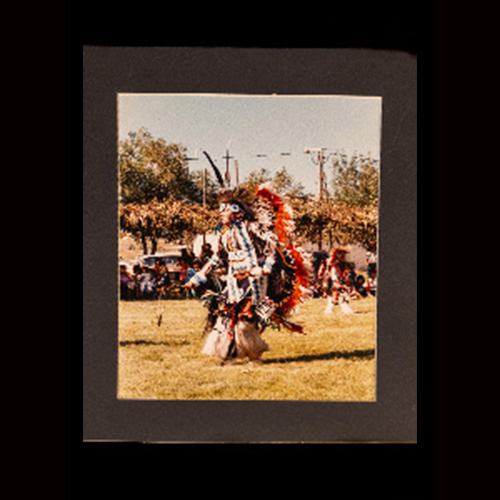
Replica Model of a Native American Tipi
Tipis are the homes of the nomadic tribes of the Great Plains, serving as an ideal dwelling for these groups, as the structures can be easily disassembled and transported. A tipi is constructed using several long poles as the frame, which are then tied together at the top and spread out at the bottom to create an upside-down cone shape. The outside is wrapped with large coverings made of buffalo hide. When arriving at a new location, the woman of each family efficiently sets up the tipi in less than an hour. In the summer, the covering is raised to allow for a large gap at the bottom, enabling cool air to flow. Additional coverings and insulation, such as grass, are used in winter to help keep the structure warm, with a fire built in the center and a hole at the top allowing the smoke to escape.
Although several Native American groups used similar structures during the hunting season, only the Plains Native Americans adopted tipis as year-round dwellings. In the 17th century, the Spanish introduction of horses, guns, and metal implements aided Plains peoples in becoming mounted nomads.
By carbon dating soil samples taken from the remains of ancient campsites and villages, archaeologists have found evidence suggesting that tipi dwellings may have been in use across the Great Plains of North America since prehistoric times.
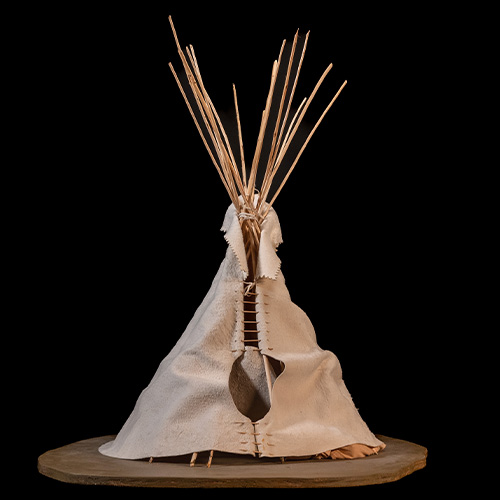
Kachina Dolls
The Hopi were the original Kachina doll carvers, using a single piece of cottonwood root. They are positioned on traditional Native American drums. Kachina dolls represent “katsinas,” spirits that were said to control natural processes like rain. The oldest kachina dolls date to the 18th century, although most of the surviving figures date from the 19th.
The Navajo and Pueblo began carving Kachina dolls in their own creative style, which is more whimsical in nature. Kachinas can be identified by their shape, color, and ornamentation, constructed with unique skill and tradition and featuring decorative materials like leather, feathers, and beads. Kachina dolls are given in the hope of future abundance and health and serve as a bridge between the spiritual world and mortals. It is believed that each year, Kachinas come to walk upon the earth and dance to bring life and renewal. In the Pueblo religion, there are more than three hundred different kachina deities, all with unique characteristics.
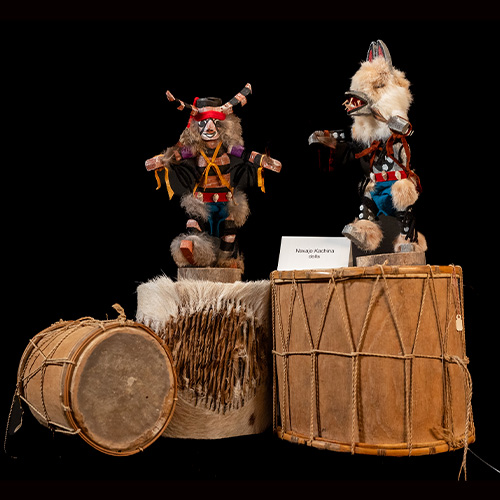
Ornamental Baskets
Native Americans exhibit excellent skills in basketry, each tribe having its own distinctive style. Using techniques that have been passed down through generations, the baskets are skillfully created to serve specific functions and are composed of materials such as ash splints, sweetgrass, willow, cornhusks, horsehair, cedar bark, swamp grass, and spruce root.
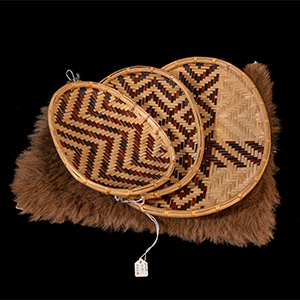
Moccasins
Moccasins are the footwear most often associated with traditional North American Natives. Many tribes have their own variations of soft leather shoes that are often adorned with embroidery or beading and are worn to protect feet from cold or wet weather. Etymologically, “moccasin” derives from the Algonquian language Powhatan word, makasin. Depending on location and available materials, other types of footwear are also worn, including woven sandals, boots, and leggings attached to shoes.
Moccasins represent more than footwear to Indigenous people. They are sacred, passed down through generations, and a physical expression of the Native journey. Rock Your Mocs began in New Mexico in 2010 as a single-day event to coincide with Native American Heritage Month. Founder Jaylyn Atsye created the event as an opportunity for Native peoples across the country to express solidarity and embrace their identities by wearing moccasins.

Buffalo Fur Purse
This handcrafted fur purse is carefully crafted from genuine hair on buffalo hide. Buffalo were once an integral part of many Native American cultures. Buffalo were not just used for their meat, although they were a staple food source of many peoples, but for their hides, their bones, and even their hooves and tendons.
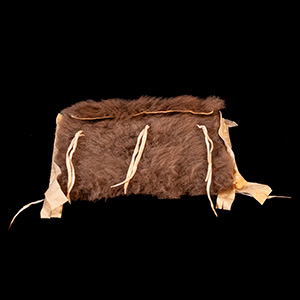
Replica Model of a Pueblo House
The Pueblo house is the traditional house of the Pueblo Native Americans of the southwestern United States, specifically New Mexico, Arizona, and Colorado. They are modeled after the cliff dwellings built by the Ancestral Pueblo (Anasazi) culture beginning in approximately 1150 CE. In a typical pueblo house, limestone blocks or large adobe bricks form the walls of each room and a central courtyard. Each floor is set back from the floor below so that the structure resembles a stepped pyramid. This enables the roof of each level to serve as a terrace for the level above. Most pueblo residential groups comprise nuclear or extended families. Traditionally, each pueblo also has two or more kivas, or ceremonial rooms.

Handmade Broom and Hand Carved Spoons
These are household items from the Lakota Sioux group. The broom is one of the most important tools for cleaning. Made of walnut, the spoons can be used for both cooking and serving.
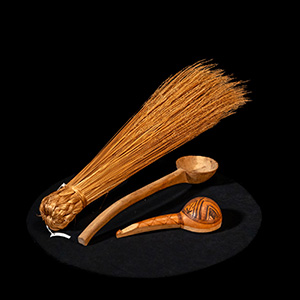
Weaving Loom
Navajo weaving is an organic craft that employs basic tools and inexpensive, usually portable equipment. The loom is simple to construct and is available in varied sizes depending on the dimensions of the rug. Upright looms have been used for centuries to produce beautiful, tightly woven fabrics, creating designs ranging from highly geometric to pictorial, limited only by the weaver’s imagination. Typically associated with the Navajo, these looms can also be used to weave the twill and plaid designs favored by the Hopi.
Today, much of the material tradition of Navajo weaving is still practiced, but most rugs are made for eventual sale. Some weavers adhere to old practices, like raising sheep, spinning wool, and preparing dyes themselves; others purchase industrially dyed and prepared yarns from local supply stores.
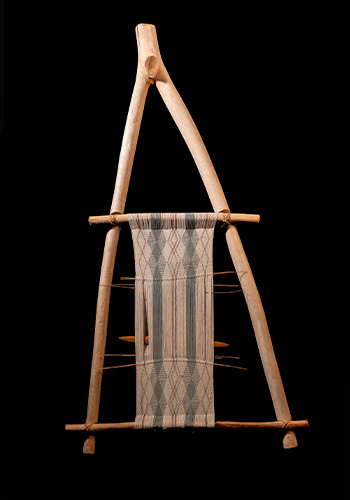
Percussion Instruments
Drums have long been an important part of Native American culture, being used for communication and expression. Drums are considered sacred and embody a life force of their own. However, the music and decoration differ among the various tribes. For many tribes, drumming is a way to connect with spiritual beliefs and entities. Many types of drums are used for sacred rituals, storytelling, and celebrations. From the powerful bass drums of the Plains Native Americans to the intricate hand drums of the Southwest, each type of drum plays a unique role in Native American culture.
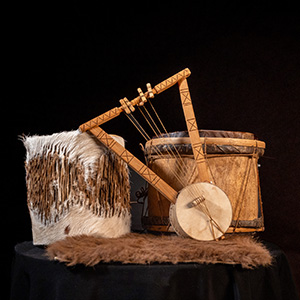
Native American War Club
This club is crafted from hardwood, and the ball of the head has been skillfully carved into the head of a warrior. Wooden war clubs are a common and versatile weapon of Native American tribes, able to deliver blows that can easily shatter the jaw or skull of a foe. Both elegant and deadly, ball-headed clubs combine refinement of form with a fearsome efficiency of function.
By the mid-19th century, this early weapon, in use by Northern Plains tribes, such as the Lakota, appears in historical references under many different names, sometimes called a death mallet, club hammer, or ball club. Many sources have claimed that Indigenous tribes created the design based on European firearms.
Clubs may be decorated for presentation or ceremonial use. The color of the beadwork on this club is significant. The four colors (black, white, yellow, and red) embody concepts such as the four directions, four seasons, and the sacred path of both the sun and human beings.

Scalping
Scalping is the practice of tearing an amount of hair, and the skin it is attached to, from the head of an enemy. Although this practice is present in many cultures across the world, not just America, it is most commonly associated with Native Americans. In Native America, scalping was considered a sign of dominance over an enemy. The ability to take a scalp signified control over one’s opponent. Scalps were kept by warriors as a sign of status, and could be passed down from family member to family member.
Wooden Bow
As with most cultures, the development of the simple bow and arrow evolved along the same way with Native Americans. Going back thousands of years, the device was used for both hunting and warfare. Carved and shaped from a single piece of wood, the Native American technique involves many months of careful craftsmanship. Typically, a man’s bow is a symbol of his strength within a tribe.
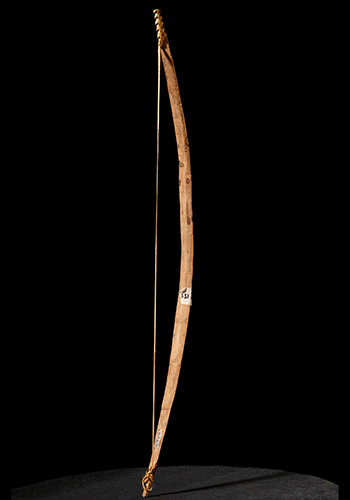
Wood, Feather Arrows
Arrows are a special part of Native American heritage, and each arrow is carefully handcrafted using wooden shafts and genuine natural feather fletching. Tribes are identified by the markings on their arrows and are indicative of the people they represent. They may be simple or elaborate, with rawhide wraps, hand beading, deer skin lacing, bits of bone, crystals, or prayer feathers. Wild turkey feathers are commonly used for creating hunting arrows, while feathers from birds of prey are used for war arrows.
